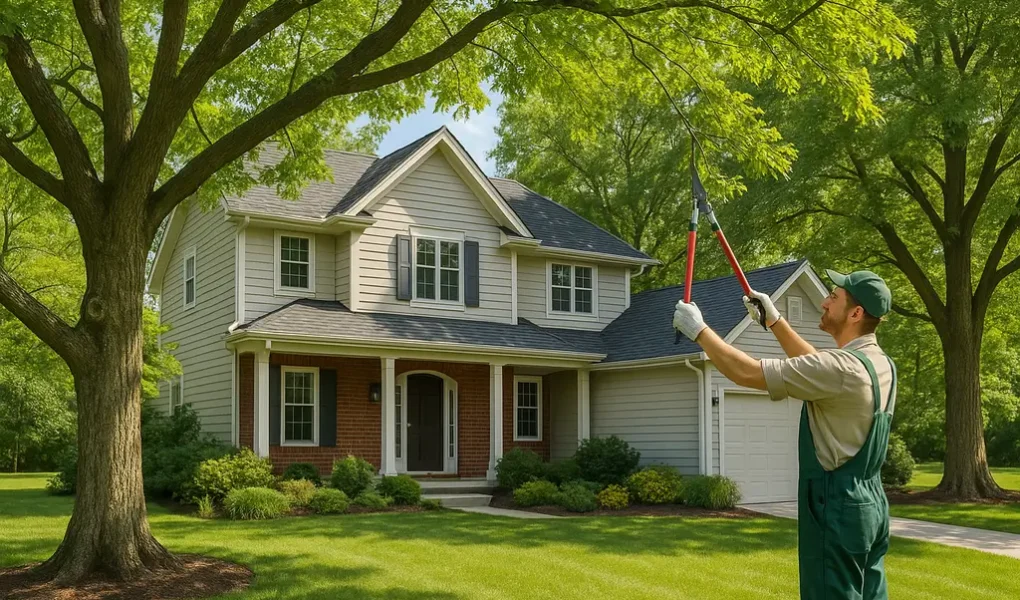When people are planning an extension or a renovation of their homes, they usually think about the building itself – more space, more light, a better layout. However, there is one aspect that is often not taken into consideration and it is what has been slowly maturing outside the walls: the old trees that have been a part of the property since decades. They are trees that provide character, privacy, shade and biodiversity but when the construction is commenced, they can be easily exposed.
Conserving and maintaining the full-grown trees is not only a gesture of environmental generosity, but also a good investment in the beauty and future value of your house. This is the way you can work out your renovation or extension project and preserve your existing trees intact and healthy.
Start With a Tree Survey Before Any Design Work
We need to know the existing state and distribution of all the mature trees in your site before you invite the architects or builders. A tree survey (sometimes referred to as a BS5837 survey in the UK) is a recording of the species, health, dimensions and root protection areas (RPAs) of your trees.
Such professional evaluation assists in deciding which trees could be safely left or which could be pruned or cut down because of disease or safety concerns. This information can then be used to have architects design extensions that do not work in opposition to your trees but rather work around them, preserving the root zones, making sure that there is sufficient light and that there will be no conflict of interest between the structure and the growth in the long run.
Pro tip: It is not an option to have a survey done, it is a legal requirement in a property within a Conservation Area or with Tree Preservation Orders (TPOs). Early filing of correct data will assist your planning application to run quicker and avoid fines or enforcement notices in the future.
Involve an Arboricultural Consultant Early
Protection of trees should not be a supplement. After you have put down your first plans, then it is advisable to seek the advice of a qualified arboricultural expert who would then be able to read the survey data and advise on any viable steps to be taken in the design and construction.
These professionals can:
· Recommendations of safe distances between foundations and root systems.
· Determine the areas where modern methods of construction (such as piles or floating floors) can minimize disturbance of roots.
· Develop a Tree Protection Plan (TPP) to be used by planning authorities that makes sure that contractors are aware of the locations of protective fencing, root zones, and access routes.
· The sooner an arborist is engaged, the less you will have to do with expensive re-designs or emergency removals in the future.
Understand How Construction Damages Trees
The failure of many trees does not come about during the construction, but in the years after the construction – when the compacted soil, damaged roots, or suffocated roots start to do their job. The main risks include:
Root compaction: The soil is crushed by heavy machinery or stored material, eliminating the air holes that roots require to breathe.
Root cutting: Foundations, utilities, or driveways excavations can cut roots that are critical to stability.
Soil pollution: Cement washout, diesel spills, or chemical run off may change the PH of the soil and poison sensitive root systems.
Level alterations: Soil added or taken away around the base of a tree can suffocate tree roots or expose them to dry winds.
When roots have been affected, it is usually too late. The slightest alteration can cause canopy dieback, fungal infections or structural instability in the long run. It is much easier and cheaper to prevent than to treat.
Create a Protective Buffer Zone
A Root Protection Area (RPA) should be made around mature trees during construction – usually a radius of 12 to 15 times the diameter of the tree at the breast height (DBH). This buffer area should be enclosed with heavy, high-conspicuous barriers (not merely tapes) to ensure that machinery, heaps of soil and workers are at a safe distance.
Inside this area:
· There should be no digging, trenching or storing of soil.
· Do not pass power or water lines through it.
· Avoid machinery traffic – even one drive-over will compress roots under the ground.
In case of space constraints, temporary ground cover (e.g. wood chip mulch and geotextile matting) may enable restricted access without damaging the soil structure.
Choose Tree-Friendly Construction Techniques
Even on small urban areas, modern building techniques can assist you in saving trees. Consider:
· Piled or screw foundations which pass over roots instead of cutting them.
· Cantilevered designs that can be used to enable floors or decks to stretch without disturbing the soil beneath.
· Driveways or patios should be paved with permeable material so that the rainwater can reach the roots.
· Mechanical trenching should be replaced by hand-digging around sensitive root areas.
These minor modifications conserve soil wellbeing and root systems – and are usually comfortable to local authorities worried about the future wellbeing of trees.
Plan Your Landscaping Around Tree Health
Once the building is finished, the focus is normally shifted to landscaping. It is your chance to save the trees and make them grow.
Apply a lot of organic matter to keep the soil moist and enhance the structure of soil.
Do not overwater or press the space containing new garden features.
Think about underplanting with shade tolerant shrubs or groundcovers which will not compete with the root system of the tree.
Use plain aeration pipes or porous paving in case the soil appears to be compacted.
The tree will regain balance between root and canopy with a healthy recovery period (two or three growing seasons).
Work With Experienced Professionals
The management of trees in and around construction sites would need accuracy, experience, and profound knowledge of arboricultural science. The homeowners and builders are not always aware of the initial signs of stress such as thinning of the crown, discolouration or fungus at the base.
That is why it can make a difference to collaborate with professional tree surgeons in Glasgow. Experienced arborists know how to check the stability of roots, how to do safe pruning, and how to care about your health before, during, and after your renovation. They carry with them professional knowledge of British Standards (BS3998), NPTC qualifications, and safety measures that ensure security of people and property.
Remember: A Mature Tree is a Long-term Asset.
It is hardly easy to replace a mature tree. New planting can also take decades to be as high, canopied and valuable to wildlife as an old specimen. Mature trees:
· Offer shade that will lower cooling expenses during summer.
· Sorb carbon and filter contaminants.
· Enhance psychological health and aesthetic value.
· Grow property value – research indicates by up to 15.
You are not only saving a tree by saving them in your renovation, you are saving the living architecture of your landscape.
Aftercare and Continuous Maintenance.
After the dust settles, you will still need to take care of your trees. Maintain an annual schedule of:
Check: Storms or high winds, broken limbs or fungus.
Pruning: Have adequate clearance between the branches and the new building to avoid structural interference.
Soil conditioning: Every year, re-mulch to store nutrients.
Watering: Even in dry seasons young or stressed trees can still require additional watering.
Consider this as a landscape post-renovation wellness plan. Trees, as well as houses, like houses, value regular maintenance.
A Balanced Future: Nature and Building in Balance.
The contemporary home design is slowly acknowledging that nature is no longer the barrier to development, it is a vital companion of the development. When you invest the time to survey, protect and care for your trees, you will have a property that is a balance of new building and living history.
The color you like, the privacy you get and the wildlife you bring will all make you remember that sustainable design starts in your very own back garden. Maintaining old trees and expanding or refurbishing is not only possible, but a plan of beautiful responsible living.
Wrapping It Up
When renovating, it is not only a matter of compliance or attachment to maintain the mature trees, it is about protecting the living resources that render a home to be established and grounded.
By being thoughtful, professional and using the appropriate methods that are environmentally friendly to trees, you can easily expand or renovate your property without losing its natural flavour.
It may take decades to grow one mature tree and just one decision to destroy it. To preserve it is a greater love of your home, your landscape, and the environment that nourishes them.




